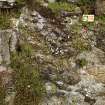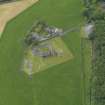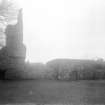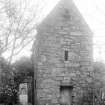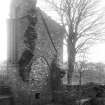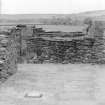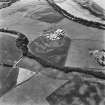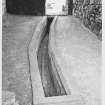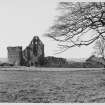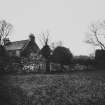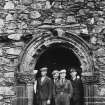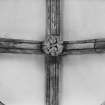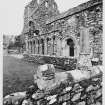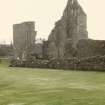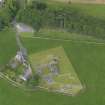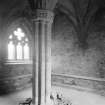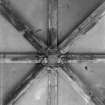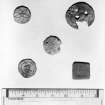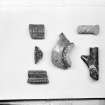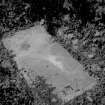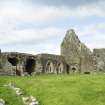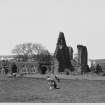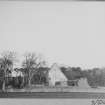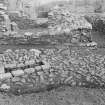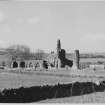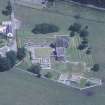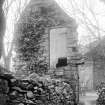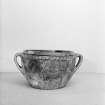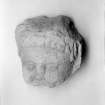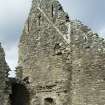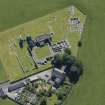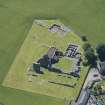Glenluce Abbey
Abbey (Medieval)
Site Name Glenluce Abbey
Classification Abbey (Medieval)
Alternative Name(s) Luce Abbey
Canmore ID 61214
Site Number NX15NE 7
NGR NX 18503 58660
Datum OSGB36 - NGR
Permalink http://canmore.org.uk/site/61214
First 100 images shown. See the Collections panel (below) for a link to all digital images.
- Council Dumfries And Galloway
- Parish Old Luce
- Former Region Dumfries And Galloway
- Former District Wigtown
- Former County Wigtownshire
Glenluce Abbey, Wigtownshire, cross-slab fragment
Measurements: H 0.48m, W 0.45m, D 0.19 tapering to 0.11m
Stone type: sandstone
Place of discovery: NX 1850 5866.
Evidence for discovery: found in 1884 in the ruins of the chapterhouse of Glenluce Abbey.
Present location: in the site museum at Glenluce Abbey (HES).
Present condition: broken edges and worn.
Description:
Trimmed for re-use as a building stone, this rectangular fragment is incised with the outline of a plain hammer-headed cross with circular armpits.
Date range: early medieval.
Primary references: Craig 1992, vol 3, 83-6, vol 4, pl 121.
Desk-based information compiled by A Ritchie 2019
NX15NE 7.00 18503 58660
(NX 1849 5867) Remains of Glenluce Abbey (NR)
(Cistercian Founded AD 1190)
OS 6" map (1957)
NX15NE 7.01 18452 58696 Abbey House
See also NX15NE 11 and NX15NE 77.
An Abbey of Cistercian monks, said to have been founded in 1190, but Easson accepts A O Anderson's date of 21st January 1191/2. J S Spottiswoode asserts that the monks came from Melrose, but documentary evidence suggests that Glenluce was a daughter-house of Dundrennan (NX74NW 12). The abbey was secularised in 1602.
D E Easson 1957
The abbey was excavated by MoW in the 1930's under the direction of J S Richardson.
A S Morton 1939; J S Richardson 1939
The fine late 15th century chapter house is complete but the remainder rarely stands above the foundation level. The water supply is a unique survival. Earthenware pipes, jointed and with inspection chambers, lie in their original positions where they are exposed to view.
S Cruden 1960
Generally as previously described and as planned by MoW. A new range of buidings, including the hospital has been excavated at NX 1849 5861.
Visited by OS (WDJ) 1 March 1968
The remains of this Cistercian abbey, founded c. 1192 by Roland, Lord of Galloway, are situated on the haughland of the Water of Luce. They comprise a fragment of the abbey church as well as, on the S, a cloister with conventual ranges on three sides, outbuildings and, on the SE, the wall-footings of what may have been the infirmary. The chapter-house, which is probably of late 15th or 16th century date, is the best preserved of the conventual buildings.
In the N transept of the church there is a graveslab dedicated to Robert Gordon of Lochinvar (died 1548), and in the S chancel-wall there is a late 17th century armorial panel impaled with the arms of Thomas Hay of Park and Janet Hamilton, his wife. In 1884 a fragment of a cross-slab, probably of 11th century date and now in the Abbey museum, was found within the chapter house. The slab bears the incised outline of a Greek cross with expanded terminals to the arms and ringed armpits.
A second cross slab (now lost), which is said to have been found incorporated in the masonry above the chapter house, bore 'an incised cross in outline and two holes cut through.' This slab may originally have come from the site of a chapel, which is said to have stood at Back of the Wall (NX c.185 585).
RCAHMS 1987, visited 1986.
NX 185 586 A small trench was dug in January 2003, across the access road between the car park and Glenluce Abbey, for a drainage channel. A fine cambered, cobbled road was found, robbed out on its E side, but otherwise preserved below levelling material for the present tarmac road. Though excavations were intended to be deeper, they were halted at this point to preserve the cobbles.
Archive to be deposited in the NMRS.
Sponsor: HS
G Ewart and D Stewart 2003
NX 185 586 A watching brief was undertaken in March 2004 while contractors carried out a programme of pipe trenching. The only features of archaeological significance comprised two sections of cobbles. Removal of most of the stones in the centre of the trench revealed a deep layer of bedding material, possibly redeposited natural stony sand lying over undisturbed subsoil.
Archive to be deposited in the NMRS.
Sponsor: HS
D Stewart 2004.
Remains of
Glenluce Abbey
(Cistercian-founded 1191)
(National Trust for Scotland) [NAT]
OS (GIS) MasterMap, July 2009.
Publication Account (1986)
Laid out on the river plain of the Water ofLuce, the
ruins of Glenluce Abbey have the remote setting, the
tranquil atmosphere, and plain austerity originally
associated with the monastic ideals ofCiteaux and its
colonies. Glenluce was founded in 1191/2 by Roland,
Lord of Galloway, as a daughter-house ofDundrennan,
but little is known of its institutional history. In the
16th century its buildings and possessions were prey
to the conflicting ambitions oflocallanded families,
most notably the Gordons of Lochinvar and the Earls
of Cas sill is, through their proteges, the Hays of Park
(see no. 29). In 1560 it had a complement of16 regular
monks, including the abbot and prior, but ordinarily
the number, excluding lay brothers, may have been
closer to 20. The monastery was formally secularised
in 1602.
The slight remains of the abbey church, which lies
across the northern end of the, site, match our scant
knowledge of its history. Except for the south transept,
it is reduced mainly to wall-footings. The layout is
clear enough, however, and conforms to the usual
Cistercian model: aisled nave, sizeable transepts, each
with a pair of chapels, and a simple unaisled and
square-ended presbytery. The surviving piers and bases
are reminiscent of the link, through Dundrennan, with
the building styles of Byland and Roche Abbeys in
Yorkshire. The floor was tiled, and there are
noteworthy monuments to the Gordons and to the
Hays, rivals even in the commemoration of death.
From the corner of the south transept the night stair
ascended to the monks' dormitory on the upper floor,
and a doorway led through to the sacristy. The
adjacent inner parlour formed a tile-floored passage
from the cloister to the burial-ground on the east.
The southern half of the east range was rebuilt in the
latter half of the 15th century, and includes the chapter
house, the abbey's main surviving claim to
architectural distinction. The capitals of its moulded
doorway bear foliaceous, seaweed-like carving. The
interior, 7.3m square, is roofed with a fourcompartment
ribbed vault springing from a central
shafted pier. Part of the original tiled floor still
survives, and the stone bench-seat for conventual
meetings runs around the wall; the abbot's stall was at
the centre of the east wall between a pair of traceried
windows.
Beyond the cellars at the end of the east range is the
base of the reredorter, or latrines-block, formerly
associated with the monks' dormitory on the floor
above. The building set at right angles to the south
side of the cloister is the original refectory; it was subdivided
in the 16th century to form the service
basement of a domestic residence with a detached
kitchen to the west. The western range of the cloister
garth originally provided accommodation for the
ancillary staff oflay brothers. The water-supply system
is a rare, possibly unique, survival, retaining as it does
the jointed earthenware pipes and lidded junctionboxes
at the base of the drainage-channels.
Information from ‘Exploring Scotland’s Heritage: Dumfries and Galloway’, (1986).
Excavation (29 April 2002 - 10 May 2002)
In April and May 2002 Kirkdale Archaeology undertook a Standing Building recording exercise while conservation work was done at Glenluce Abbey.
G Ewart 2002
Sponsor: Historic Scotland
Kirkdale Archaeology
Excavation (13 January 2003 - 14 January 2003)
Under the terms of its P.I.C. call-out contract with Historic Scotland, Kirkdale Archaeology were asked to undertake archaeological monitoring during the cutting of a trench across the access road to the Abbey and Abbey House. The works were intended to alleviate the problem of the flooding of the custodian’s office from rain water coming down the access road. The method of solving this problem would be to cut a shallow drain across the width of the road and to direct surface water into the adjacent field to the E. The archaeological implications of this work were unknown.
The interpretation of this small excavation is that a fine early cambered cobbled street exists below the line of the present tarmac Abbey access road. The E third of the width of the cobbling appears to be robbed away and replaced by late levelling material suggesting the stones may have been removed during the modern road construction. The raising of the level by c.200mm, when the tarmac road was being laid, required the depositing of crushed quarry material to level up the surfaces, so burying the early cobbled road and thin mud covering.
G Ewart and D Stewart 2003
Sponsor: Historic Scotland
Kirkdale Archaeology
Watching Brief (1 March 2004 - 3 March 2004)
NX 185 586 A watching brief was undertaken in March 2004while contractors carried out a programme of pipe trenching. The only features of archaeological significance comprised two sections of cobbles. Removal of most of the stones in the centre of the trench revealed a deep layer of bedding material, possibly redeposited natural stony sand lying over undisturbed subsoil.
D Stewart 2004
Sponsor: Historic Scotland
Kirkdale Archaeology
Note (25 November 2021)
The location, classification and period of this site have been reviewed.










































































































